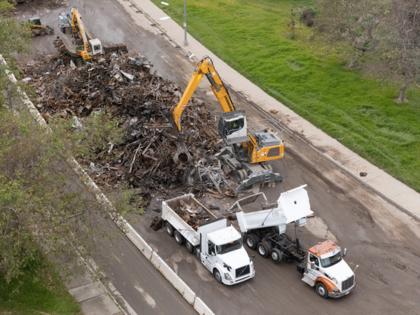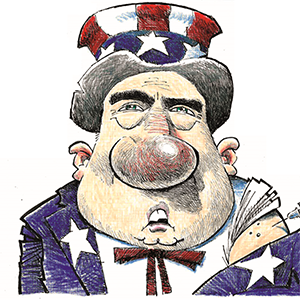As heavy as 100 Eiffel towers: Monumental LA County fire debris removal could finish by June
Published in News & Features
LOS ANGELES — A small army of laborers, heavy-equipment operators, hazmat technicians and truck drivers have cleared more than one-third of the home lots left in charred ruin by January’s firestorms — a frenetic pace that suggests the bulk of the vast government-run cleanup in Los Angeles County could be completed as early as June, officials say.
U.S. Army Corps of Engineers officers overseeing the effort said the crews of mostly private contractors are working at a record clip for a wildfire recovery, clearing nearly 120 lots a day and operating at close to the capacity that roads — and residents close to the fire zones — can tolerate.
The scope of the unfinished work came into clearer focus last week, with the passing of the April 15 deadline for residents of Altadena, Pacific Palisades and Malibu to opt in or out of the cleanup.
Some 10,373 property owners completed “right-of-entry” forms, authorizing the Army Corps and government contractors to work on their properties, while 1,698 others opted out of the program, many because they wanted their own crews to perform the work.
Army Corps of Engineers commanders reported that 4,153 properties across the Eaton and Palisades burn zones had been cleared by Thursday, though the total declared as “complete” is lower because many of the lots still need finishing touches — including the removal of hazardous trees, installation of fencing around pools and application of “hydro-mulch” sealant to prevent erosion.
Los Angeles Mayor Karen Bass held a news conference Thursday to mark 100 days since the fires and to tout the speed of the recovery. “The Army Corps of Engineers are heroes in Los Angeles, are heroes in the Palisades,” said Bass, standing alongside Army commanders and Westside Council member Traci Park. “It is amazing to come here day after day. ... Every time I come, I see more and more properties cleared.”
The Army officers commanding the cleanup say it is the biggest their agency has ever conducted in a wildfire zone. With more than 1 million tons of concrete, steel, earth and plants already removed from the burn areas, two colonels overseeing the operation reached for superlatives to describe the scope of the work.
The weight of the debris removed equals the weight of 100 Eiffel towers, said Col. Sonny Avichal, the West Point graduate overseeing the Altadena fire cleanup. The weight taken out of the Palisades, alone, is equal to a row of Ford F-150 pickups, lined up end-to-end and stretching from Los Angeles past Salt Lake City, said Col. Brian Sawser, another West Point grad, who has overseen the Palisades fire cleanup.
“This has been very similar to a war-fighting approach,” said Sawser, referring to the military’s strategy of bringing together diverse personnel, organizations and processes and unifying them in a common purpose. He later pledged: “Renewal is coming, it’s coming. And we’re bringing it to you as fast as we possibly can.”
Avichal said the mission requires brute force but also a soft touch, as when an elderly woman in Altadena recently asked a cleanup crew for a personal treasure buried in her home’s rubble. The workers soon recovered a small safe and the gold coins inside it, delivering the bounty to the beaming homeowner, a moment captured in a Facebook video.
“At the end of the day, it’s about the human touch,” Avichal said, recognizing the workers who returned the coins to the owner. “It’s about the compassion we have for the individuals who lost their homes.”
The cleanup has ramped up considerably in recent weeks.
When Avichal arrived in February from his base in Virginia, there were only 20 crews clearing lots in Altadena. (Each crew consists of, at minimum, a quality assurance official from the Army Corps; a task force leader from the principal contractor, Burlingame-based ECC; a heavy-equipment operator; a crew leader; and several laborers.) Now 129 crews are clearing properties in the San Gabriel Valley community.
It takes a little less than two days for workers to finish clearing a property, slightly less than the time needed in the Palisades, where lots tend to be larger, and in Malibu, where some of the work has been complicated because of the precarious perch of more than 300 burned homes along the beach.
The fire zones now teem with lines of trucks, earthmovers and workers in yellow-and- orange safety vests. The air thrums with the din of destruction — giant excavators clanking against steel beams, trucks bleating out warning signals as they back into position, green organic material whooshing out of hoses onto finished sites.
While the images can appear chaotic, they are the result of hours of planning and preparation.
Homeowners typically receive a call two or three days before crews arrive. A staffer from lead contractor ECC asks for important property details: Are there septic tank lids or propane tanks that need to be avoided? Are there pet graves that must be left undisturbed? Do workers need to be on the lookout for squatters?
An initial inspection crew, commissioned by the U.S. Environmental Protection Agency, then screens each property in search of paints and other toxic substances. Analysts also probe for asbestos — a job that expanded as the carcinogenic material turned up in many more locations than expected.
Workers have found asbestos in more than 60% of homes in Altadena and more than 40% in the extended Palisades fire zone. Cleanup crews in white hazmat suits and respirators typically needed up to three days to scrape away the material and remove it in sealed containers.
“At one point we had 95 crews doing nothing but asbestos abatement,” Avichal said.
On the Westside, the debris removal has been complicated by the constricted roads in and out of the burn zone. Traffic flow along Pacific Coast Highway has been reduced to one lane in each direction and Temescal Canyon Road remains closed to create what the Army leaders call a TDRS — Temporary Debris Reduction Site.
Heavy excavation machines bash giant concrete blocks into more manageable chunks, before grinders pulverize the material into 1- to 3-inch rocks, which can be recycled. Steel and other metals also get compacted in the recycling zone before being trucked away.
By doing the reduction work close to the disaster site, debris that initially filled three or four dump trucks can be consolidated into one large semi tractor-trailer load. That means that the total truck traffic leaving the burn areas is reduced substantially.
Anthony Marguleas, a real estate agent active in rebuilding efforts in the Palisades, called the debris recycling effort “a clear win for the community,” in that it reduced outbound truck traffic and also appeared to be “efficient and environmentally responsible.”
State insurance Commissioner Ricardo Lara said in January that homeowners have typically spent more than $100,000 when they paid to have private contractors remove debris after recent wildfires.
Those who opt in to the government program have no direct out-of-pocket costs, though the Army Corps of Engineers will ask insurance companies that cover debris removal to reimburse the government up to the limits of that specific coverage.
The pressure for progress abounds throughout the fire communities, as homeowners plead for access that will allow them to start rebuilding. But the drive to complete the work is particularly high along PCH in Malibu, where 327 homes burned.
The extra anxiety has multiple causes: The charred remains of homes continue to wash away, spilling contaminants into Santa Monica Bay. Caltrans crews need access to ensure the ground under PCH does not erode. And the the sooner the work is done, the sooner access might improve along the highway, a lifeline for residents and for businesses that depend on customers coming from Santa Monica and points beyond.
Sawser said last week that the Army Corps-led crews would be “tripling their effort” along the coast, with as many as a dozen crews clearing home sites, compared to the three or four that had operated there before.
“That highway is the linchpin to everything that we do,” Sawser said, “because we not only have to clear that debris for many reasons, we also need to have the highway to move material out of a lot of other locations.”
Though the cleanup crews have drawn wide praise, the work has not been flawless. A homeowner complained at a recent hearing in Malibu that an excavator has mistakenly began to plow up the concrete slab under her ADU. She caught the mistake before the destruction was complete and the contractor later told her by phone that the company would pay to repair the damage.
And some health officials and residents have questioned whether the lot clearances have gone far enough. The Federal Emergency Management Agency decided to not follow past practice of testing the soil after disasters for contaminants. Those tests typically had been used to determine whether cleanup crews should remove more than the first 6 inches of topsoil.
After the twin L.A. fires, FEMA announced it would not conduct the soil testing on cleared lots, drawing criticism that the cleanups would not be truly complete. Those reservations gained some traction earlier this month when soil testing by Los Angeles County in and around the burn areas found concerning levels of lead.
The potential adverse impact of the work has also generated pushback in neighboring Southern California communities, given the more than 2,000 truckloads of earth, concrete, metal and other debris being shipped each day to 16 landfills and recycling centers around the region.
The Simi Valley Landfill & Recycling Center has taken by far the biggest share of the fire detritus, receiving an average of 1,228 truckloads a day last week and a total of 636,000 tons of debris since the cleanup started. The Sunshine Canyon Landfill in Sylmar, the second biggest fire debris repository, has received 126,000 tons.
From Malibu to Calabasas, Altadena and Irwindale, residents around the burn zones and the communities where the debris is being deposited have expressed fears that toxic materials could be released into the air and soil.
Contractors have responded that they are taking considerable care — including frequent watering of home lots and waste consolidation sites — to keep pollutants out of the air. Into mid-April, the protests and a lawsuit by the city of Calabasas had not succeeded in redirecting the debris.
On a recent weekday afternoon, debris trucks lined up for several hundred yards outside the weigh station at Simi Valley Landfill & Recycling Center. Once inside, trucks lumbered up a long, curving road into the hills. Then came another wait to dump their loads — an untold number of incinerated living room sets, teddy bears, running shoes and other detritus, spilling into a final resting place.
An enormous cloud of gulls billowed and swooped around the charred waste.
“Everything we owned and gathered over 35 years was hauled away in like three trucks,” said Eitan, a Palisades man who declined to give his last name. “It’s almost a biblical kind of conclusion, from ashes to ashes. That’s for humans but, in this case, it’s for all of those objects as well.”
©2025 Los Angeles Times. Visit at latimes.com. Distributed by Tribune Content Agency, LLC.







Comments